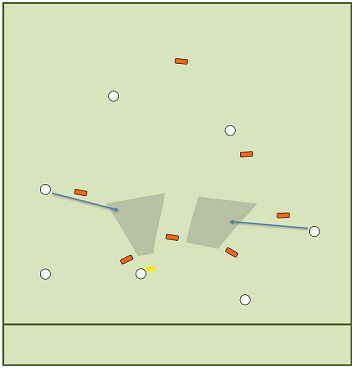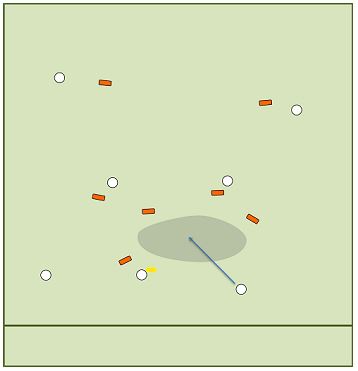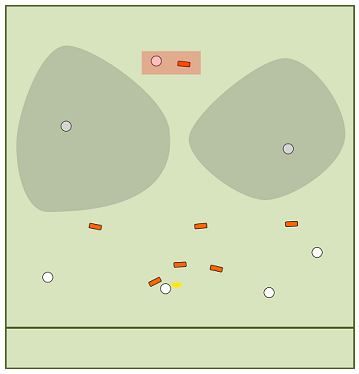4 Fundamental Principles of Zone Offense

Every team has faced a tough zone defense that they just can’t seem to crack. In the most popular UAP Classroom video of all time, Ben Wiggins systematically deconstructs every strategy for both zone offense and defense. After watching the presentation, you will be equipped with the knowledge to lead your team past any zone. In this post, we will examine the ways that an offense’s priorities should progress as a typical zone adjusts throughout a point or game. For example, zones that aggressively pressures the thrower to stop forward passes may be susceptible to an around attack by the offense. We will see that defenses continue to adapt their formations as we find new holes in them, all the time giving up different options to the offense.
Step 1: Establishing the Around
“Swing the disc!” If you’ve ever coached or been coached, you’ve heard this mantra. Moving the disc laterally is often the first principle to success in any offense—and zone offense is no different. If the defense is allowing throws to go from sideline to sideline for any gains, your team should take those throws. These throws are often uncontested, and your team may be able to gain 10-20 yards by simply swinging the disc a few times, as shown below. If the defense does not adjust, you could even work the disc all the way to the endzone without ever throwing a difficult, contested throw.
Depending on the level at which you are coaching or playing, it will take varying amounts of time for the defense to adjust. In elite-level club games, a defense may make several adjustments throughout the point. In more beginner-level games, the adjustments may come solely between points. Regardless, every zone will eventually adjust if the offense is gaining free yards by swinging the disc from side to side. Whenever a defense makes these adjustments, an efficient offense can themselves adapt by moving to step 2.
Establish the Around: The offense has gained positive yards by avoiding the defenders and throwing around the zone.
Step 2: Attacking Through the Defense
After the offense has found some success swinging the disc, the defense will adjust their positioning to contest these lateral throws and deny the free vertical yards gained from them. This is most often done by spreading the front defenders, as shown in the picture below. These front defenders are now in a position to contest both swing throws from the first diagram, making the around a riskier option. When the front of the zone spreads, this will open up throws through the defense. Great throwers may be able to open gaps for through throws right away by faking, but any offense that has successfully established the around will eventually be able to find these same holes in the defense.
As the front of the zone spreads, several downfield offensive players should assume the role of “poppers,” looking to occupy open alleys of space in between the front and the second level of the defense. After establishing the around, these alleys will become wider, allowing for easier throws through the front.
Attacking Through the Defense: As the defensive front spreads out, poppers look to receive through throws in open spaces behind the front.
Step 3: Moving Inside the Front
Successfully completing just a few through passes can often move your offense down the length of the field, so defenses are typically quick to make adjustments that deny these throws. One common way defenses adjust is by dropping the front defenders farther away from the disc. This allows them to deny the open spaces that your poppers are looking to exploit, while maintaining the ability to attack wide throws around the defense. This moves you to Wiggins’ third step to combating a zone defense: moving inside the front.
These inside throws (not “inside” breaks!) are short, easy throws from handler to handler that gain positive yards into the space in front of the defense. In addition to easily gaining yards, these inside throws will often shrink the distance between the new thrower and the front of the defense, negating the advantage gained by the sagging defenders, and creating new opportunities for throws through the defense.
Moving Inside the Front: As the front sags back, handlers can receive yards inside the defense. This can be coupled with the new thrower looking for a quick through throw to a popper.
Step 4: Throwing Over the Defense
If sagging the front defenders does not work, then the defense must resort to moving extra defenders forward to help the front defend the around and through throws, without giving up inside gains. When this happens, the offense around the disc suddenly becomes very cluttered, with little gains possible by throwing to nearby teammates. What this adjustment opens up are the over throws. These overs (hammers, blades, etc.) are thrown to deeper offensive players occupying the vast open spaces behind the second level of the defense.
Many coaches shy away from teaching overheads to all players as a fundamental part of a throwing arsenal, but this last adjustment demonstrates the value of having effective overheads throughout your roster. These throws do not have to be pinpoint accurate throws straight into the player’s chest; they only have to be thrown into the large open space where the player can track it down and catch it.
A crucial note to successfully completing overhead throws is that the last back defender must be forced to guard an offensive player away from the spaces being thrown to. If the deep defender can guard 2 players at once, then the offense will have trouble finding open overs. If this situation occurs, the deep offensive players should spread out and force the last back to pick only one player to guard, leaving the others open for an overhead throw.
Throwing Overhead: As the second level of the defense moves forward, offensive players can find large open spaces behind the defense. Notice that the last back defender is being forced to guard a single offensive player.
Conclusion
A key point to understanding zone offense is realising that these adjustments are a progression. The through throws will not become easy until the defense has been forced to respect the around. It will be difficult to gain positive yards on inside throws until the defense sags off to prevent through throws. Overs will not open up until the second level of the defense moves forward to help cover the gaps being exploited by around and through throws.
No two zones are exactly the same! It is important to be aware that certain defenses will force you to start at step 2, or 3, or to cycle through these adjustments in a different order. For example, a team may initially present a very aggressive zone, requiring an offense to immediately look to overheads. Depending on which defenders drop back to cover this space, and what space is left open, the offense may then either attack the around, throw through the front, or move inside the front.
Want to learn more?
You can find the full (1:20:00!) video in the UAP Certification package. In addition to the concepts described above, Wiggins’ presentation includes:
- analyses of how to progress through alternate zone sets;
- a defensive perspective on where to find blocks with different zones;
- and breakdowns of each individual role on both offense and defense.
Along with all of this, the UAP Coach Certification package contains 12 more videos to teach the most critical skills of coaching ultimate. Completing the course will certify you as a UAP Coach, and help you become the best coach you can be! For UK and Canadian coaches, you may be eligible for development points from UKU and Ultimate Canada.
You can also visit our Ultimate Frisbee Strategies page for other quick insights into various strategies of ultimate frisbee for both offense and defense.
About Ben Wiggins
After playing ultimate with the University of Oregon and winning the Callahan Award, Ben moved to Seattle and joined the team for Sockeye's first title run in 2004. As a captain and primary offensive handler, Ben would go on to win two more UPA championships with Sockeye as well as two silver medals at World Championships. Along with Andy Lovseth, Ben founded and ran The-Huddle.org, a high-level strategy and tactics online magazine for ultimate. Previously the coach of Seattle Voodoo, Ben is currently retired from playing ultimate.





